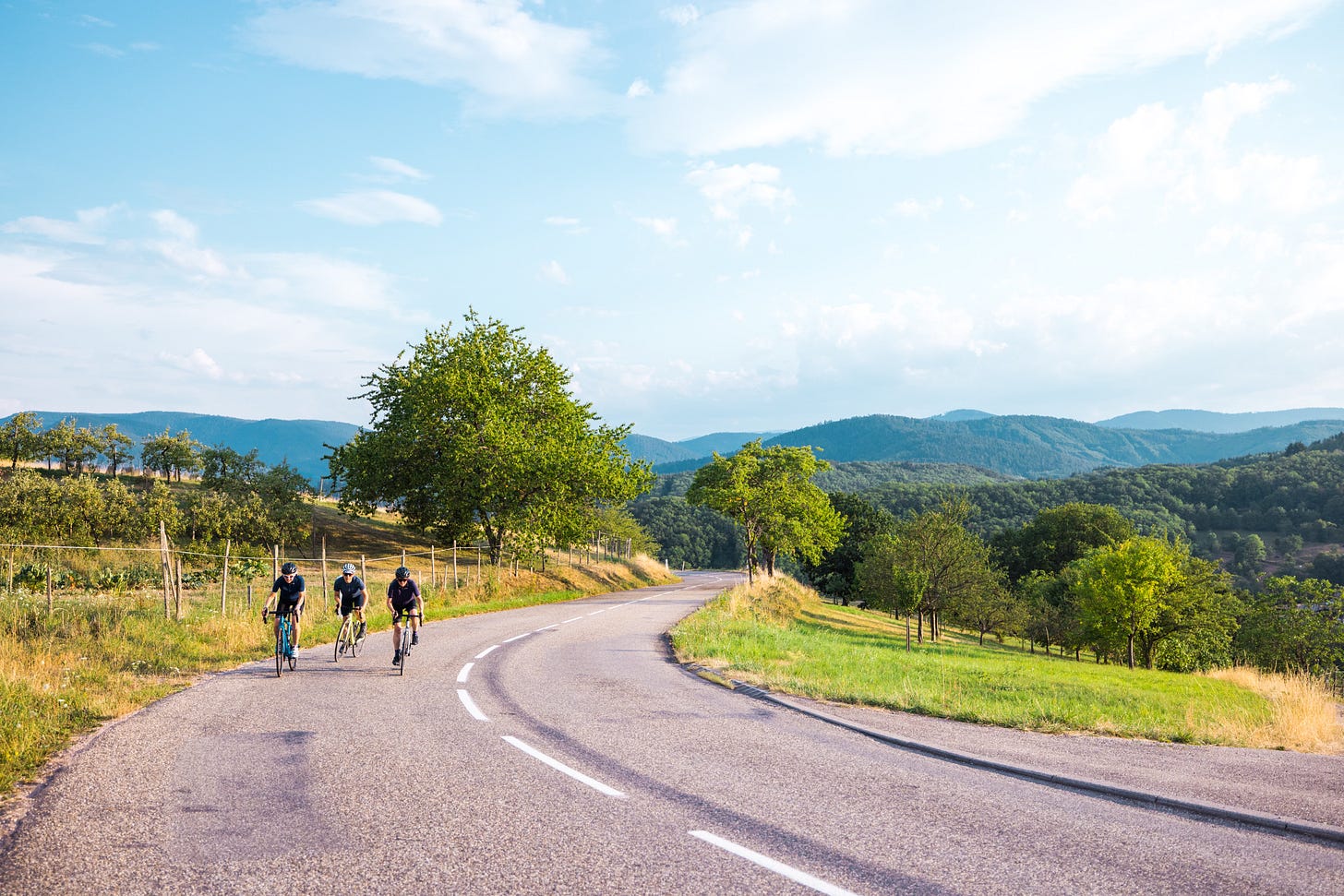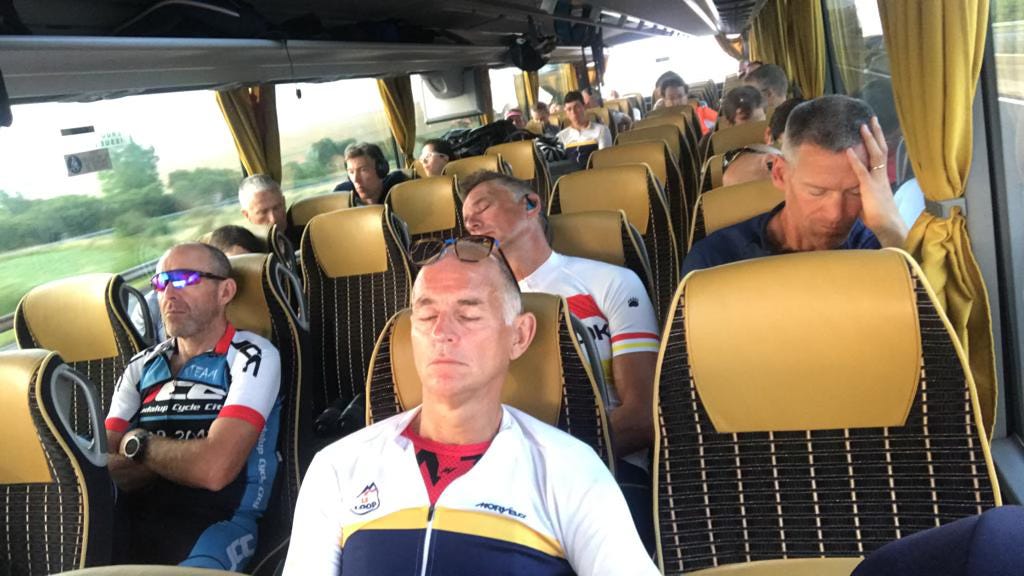July has crept up on me, and all of a sudden it’s less than a week before I set off for France. I won’t be riding the men’s Tour de France route this year, as I have in the past – I was lead cyclist for Le Loop for several years – but my friend Ayesha and I are planning to bikepack the route of Tour de France Femmes, just three days before the race passes through.

We’ll be starting in Bretagne on the 23rd. (I have decided not to ride Stage 1, in my current spirit of non-completionism, and will instead be spending the day with another friend in Brest.) And we’ll be finishing in Châtel, near the Swiss border, after tracing a very pleasing line straight across France, through some of its very best cycling regions – as soon as they announced the route, I could see that it would make a wonderful tour, and started making plans to ride it.
But unlike a classic bike tour, of course, Grand Tour routes include a lot of transfers: after finishing a stage, the racers will be bundled onto buses (or in some cases flights), and the entire entourage will drive to the start of the next stage, which could well be several hours away.
When I was working on Le Loop, some transfers would happen at the end of the day’s ride – we’d hang around in a car park or town square, waiting till enough of us had finished to fill up a bus, and then sit there in our disgusting lycra (or in spare clothes we’d stowed in our day bags for this purpose), snacking and hydrating and chatting and snoozing as we made our way to the hotel we’d ride out of in the morning. On other days we’d have a morning transfer, which would involve getting up very very early (I think once or twice I had to set my alarm for 4.45), and catching a few extra winks as a bus took us to a distant car park where the staff (who had got up even earlier) would have laid out all of our bikes in tidy rows.1
But at least we had someone to plan all this for us, to book the coaches in advance and call the previous day to check they’d show up, to persuade the hotel to serve an early breakfast, to tell us what time to set our alarms and crucially, to make the decision about whether to transfer before the ride or after.2 During the recce, which took place 6-8 weeks earlier, I would have to manage on my own. Sometimes, very rarely, there would be a convenient train that linked the town I arrived in with the town I would ride out of the following morning. But usually there wasn’t, and in many cases I would just have to ride the transfer; sometimes appending extra mileage to the beginning or end of a day, and sometimes adding an extra day to my itinerary. I didn’t mind this at all – the recce was a solo adventure, albeit with some work requirements, that was secretly one of the highlights of my year. But I would be unbelievably tired and hungry by the end of it. Riding the same stages a couple of months later, with Le Loop, made me realise just how great the difference is between supported and unsupported.
Ayesha and I are doing this all on our own. So my last few weeks have been spent crouched over a laptop, organising two weeks’ worth of accommodation, and trying to untangle the successive logistical conundrums of how to get between two distant cities when there is no train, whether to stay at the start or the finish of each stage, and how to get my bike to and from France via train routes that make it almost impossible. I think everything is now in place. (Touch wood, touch wood.)
The final puzzle piece was how to get from Albertville to Praz-sur-Arly on the morning of the final stage, ideally without paying €90 for a taxi, and after both of us had spent hours trying to find a solution, I gave in and asked if anyone on social media could help. Within a few minutes a kind man called Rob had responded, to say that he would be in the area that day, and was happy to give us a lift.
So, as long as we manage to get through each day’s cycling, I think we will make it.
My riding buddy is the formidable Ayesha McGowan. We’ve been friends since 2016, when I found myself in San Francisco, where she was living at the time, and asked if we could meet. I’d been in awe of her ever since she confidently stated her intention, in an interview with Vice magazine the previous year, to become the first African-American professional female road cyclist. A few months later she appeared in this 4-minute BBC video, and re-watching it almost a decade later has just given me shivers down my spine – and made me realise all over again how lucky we are to have Ayesha as an athlete and an activist. She announces:
I’m going to be the pro that I couldn’t find in the sport. I owe it to all the little girls who look like me, who have the potential to become great.
But, with what I think is extraordinary courage, she admits that this ambition might be beyond her abilities.
Even if I don’t become the best in the United States, I know I can still accomplish my goal of encouraging and inspiring other women of colour to go for it. Because maybe they are the one that’s supposed to become the best. I’m just trying to lead the way.
Looking back on this, almost ten years on, I marvel at the vulnerability of publicly committing to such a lofty goal, with no assurance that it would ever be possible.
Ayesha did, in fact, eventually become a professional cyclist. But just as she told us back in 2016, this was really only part of her mission. She has succeeded even more emphatically in bringing other women of colour into the sport, and not just by giving them an inspirational role model to look up to. Through her company, A Quick Brown Fox, she has provided direct practical support to women of colour in cycling, through race fee sponsorships, workshops, training camps, and Do Better Together: a virtual fitness community. She hadn’t just achieved her own ambition – she’s brought countless people along with her, and progressively changing the face of cycling.
So far Ayesha’s programme has supported over 80 women, and funded more than 900 days of racing in the US – with plans to expand to Europe within the next couple of years. And by riding the route of Tour de France Femmes, we are hoping to raise money to help her continue this work. If you’d like to find out more – and donate – head over to her website. And if you’d like to follow our adventures, which are likely to be quite entertaining, the best place to find us both is Instagram: Ayesha’s here; mine here.
And as for whether I really have it in me to ride grand tour stage routes that vary from 110km to 165km – well, my plan is to do what I talked about in last week’s essay: ride like it’s Day 9 of an ultra-race, just keep plodding forwards, don’t waste energy trying to sprint, no one cares if you use the small ring. I haven’t told Ayesha this yet…

The worst transfers I remember are the 12-hour drive between Sønderborg and Dunkerque in 2022 (actually not so bad, as the only way ASO could make this work was to work in an extra rest day); Stage 15 in 2019, when we woke up in a Brutalist hotel near the top of the Tourmalet, and had to be driven nearly four hours to Limoux, to start riding a 185km mountain stage that would end in Foix, back the way we’d come (it didn’t look so bad on the map, until you realised that the route didn’t follow the anti-clockwise progression of the Tour, but instead sent us briefly east-to-west – riding from Foix to Limoux would have been far easier); and the final transfer from Val Thorens to Paris where, after riding a 130km mountain stage (it was shortened to 60km in the following week’s race, owing to a landslide that blocked the Cormet de Roselend) we spent several hours on a bus, slept for half a night in a hotel near Lyon, then drove another four hours to Paris, to ride another 130km, drink champagne on a boat on the Seine, and then collapse with exhaustion.
This was based on all sorts of factors. We might transfer post-stage if the following stage was going to be a particularly hard one, deserving of the luxury of riding hotel to hotel. We might transfer pre-stage if the start town didn’t have enough hotel beds for 100+ riders. On a few occasions neither did the previous day’s finish town, in which case we’d have to stay in some third location, and transfer at both ends. Quite often when we finished on Alpe d’Huez, the next day’s stage would start down the hill in Bourg d’Oisans, and we’d transfer by bike, since it was probably quicker to ride down that hill than it would be to go by bus. Increasingly in recent years the Tour has grouped stages geographically in a way that means we’d get two or more nights in the same hotel. (For example, this year’s rest day in Toulouse is followed by a stage that starts and finishes in Toulouse, meaning riders will probably get to return to the same hotel room three nights running.)





